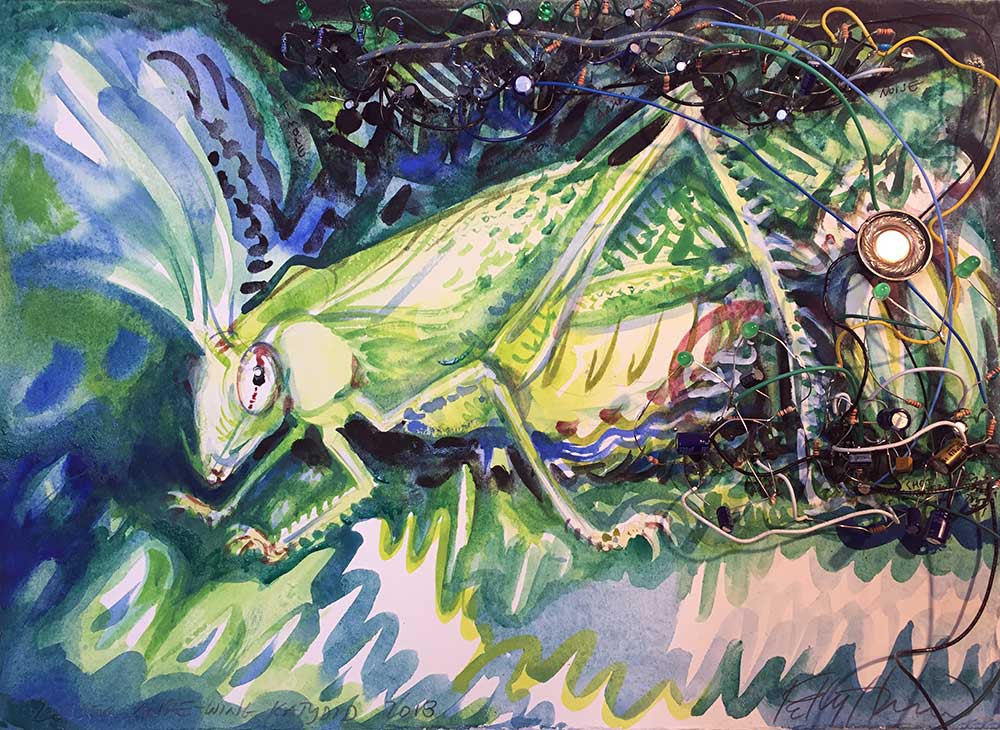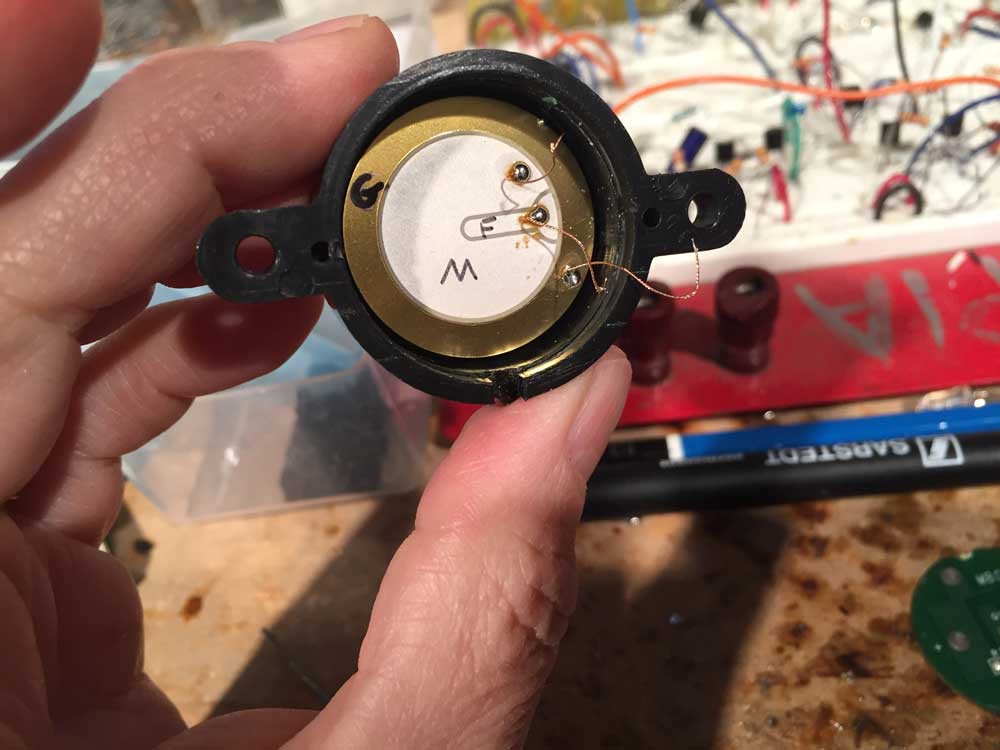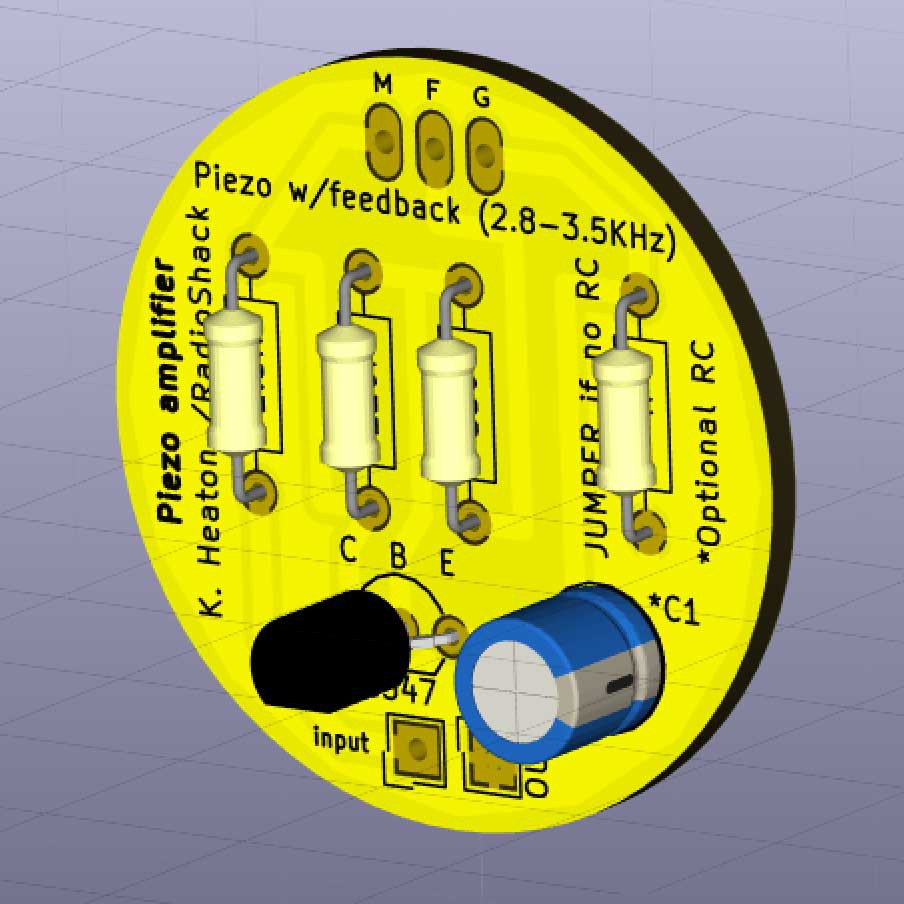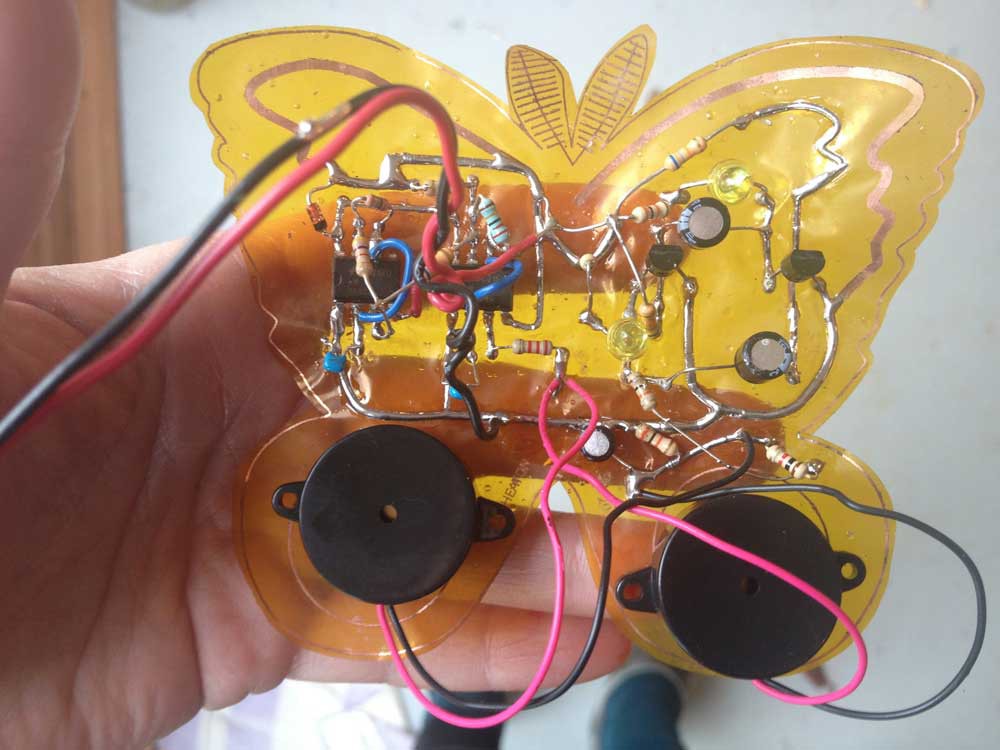-
Lesser Angle-winged Katydid
10/02/2018 at 00:30 • 0 comments*This log is an extension of my last entry, so please start there if you want more information about how the following work of art was made.
![]()
I finished breadboarding my circuit for a Lesser Angle-winged Katydid. Then I forced myself to document it with a schematic -- "forced" because my tendency is to go on inventing things and forget my design history, and I have learned the hard way that I must solder an instance of my schematic to be sure that it's accurate. It's all good, though, because building a permanent circuit gives me a future reference to use alone or in parallel with other sound-generating circuits. Many of my circuits are sensitive to noise, so I try to test them in combination before I send out board designs or embark on a larger piece.
I got into the habit of making these electrified watercolor studies in the days before I used software for schematic design and printed circuit board layout. You can see images of early works here. As time goes by, these studies help me to remember why I designed the circuit in the first place, like a bookmark for a time and place in life. I realize that there are more practical ways to archive a circuit, but it's a good excuse to make art.
Here is a video of the Katydid "rattling." I included a couple of crickets to give the Katydid's sound a more natural context.
To conclude this log, it occurs to me that some of you might not have drawing or painting skills. While I can't teach you to be an artist, I can suggest this useful hack: project an image and trace it. Please refer to the instructions associated with this project for more details on "How to draw if you have no artistic talent."
-
Percussive bugs: rattle, sizzle, resonance
09/29/2018 at 00:18 • 0 commentsIn the southeastern United States, the ring-tone chirping of crickets at night is accompanied by a percussive rattle that's common from mid-summer through fall. Where I live in northwestern Virginia, the dominant percussionist in our nighttime chorus is the Lesser Angle-wing Katydid. Similar to cicadas in timbre, but far less annoying, these bugs "shake their rattle" intermittently, calling once or twice and then going silent for five to fifteen seconds. Compared with a regularly chirping cricket, the delay adds complexity to an analog audio "Katydid circuit." You have to create the timbre and tempo of a rattle sound, and then you have to space out "packets" aka "envelopes" of this effect with silence in between --ideally randomized for natural effect.
In a first step, I built a machine gun circuit using a 555 timer. While the tempo is right, the timbre of a square wave is dull compared with a Katydid's sizzle and resonance. I reverted back to my cricket strategy and built two discrete transistor astable multivibrators, but that didn't work either because the simplicity of my cricket circuit depends heavily upon the acoustical properties of a 2.8 KHz piezo disk element. Katydids are resonant in a different frequency range than crickets. To make a long story short, I had to build a filter.
After some reflection on the sound quality of a Katydid, I decided that I needed a filter for "snare" or "high hat" as used in analog drum machines. Research led me to this very handy circuit by A. MAGIC PULSEWAVE:
![]()
With some minor adjustments (not needed for functionality--purely my preference), this circuit works perfectly to add sizzle, resonance, and noise to the output of an astable multivibrator. Note that I decided against a piezo disk element because --for a Katydid-- I prefer this little speaker (now obsolete but hopefully similar exist or I have more reverse engineering in my future). Here's a video clip to demonstrate the Katydid sound timbre. Notice the subtle complexity thanks to amplified noise from the abused bipolar transistor (gosh, horrible sentence out of context).
Since I'm on the topic of speakers and timbre, here's another video showing an overview of the circuit (including a second astable multivibrator for regular chirp) in which I demonstrate the Katydid's rattle through several different types of speakers. I end with a cool way to "play" a piezo disk in its housing. Electronic musicians: even if you find the earlier part of this video boring, check out the last 10 seconds for inspiration on how to physically manipulate the output of your synth to get a new electronic sounds.
Because I am piezo-obsessed, here's one more clip showing a bare piezo disk element as the output for this circuit (which provides sufficient amplification that my custom printed circuit board is not needed). I mess around with different connections to the feedback of the piezo (white wire), the last seeming to make a change -- a potential source of interesting effects that warrants further exploration. At the end of the clip, I show how the piezo sounds (differently) in different positions inside of a plastic housing.
In my next video, I show some of the cool effects that you can get by playing around with capacitors in an analog circuit. Be forewarned that you risk blowing one of your components (so careful if you don't have replacement parts). It amazes me how much one capacitor can change the behavior of a circuit -- and this fact extends to resistors and diodes as well. Especially note the weird chatter sound that I get about 1/2 way through this clip (start at 00:36).So what does this say about Katydids --the ease with which capacitance alters "their" sound in an analog electronic circuit? Of course, my entire approach to hacking nature's musicians could be a logical fallacy. Maybe analog electrical engineering tells us little or nothing about the inner workings of nature and I just *feel* like there's a comparison to be made. Oh well. There's no accounting for the compulsions of an artist. But seriously, all you entomologists out there, what do you think?
-
Crickets: nature's favorite astable multivibrator
09/25/2018 at 15:42 • 0 commentsWhat rural soundscape would be complete without crickets?
What is it like to be a cricket?
It's one thing to listen to their rhythmic chirping, but imagine spending your life singing the same tune indefinitely, changing tempo in response to heat, and only shutting up when you're afraid of imminent death. Wait, how is that different from human thought chatter? I digress.
Crickets are an excellent way to explore the basic, fundamental building blocks of electronic music: oscillators. Specifically, crickets taught me about astable multivibrators -- a term which, for those uninitiated in EE lingo, is probably the last thing you would search in your quest for "how to build an electronic cricket."
An astable multivibrator is a circuit that bounces back and forth between two states (and will do so indefinitely until you disconnect power). It's like a perfect Pong volley -- and therein lies its great strength and weakness. You can use an astable multivibrator to generate a consistently oscillating waveform. This gets acoustically (or visually) boring after awhile and in later logs I will show you how to introduce randomness. But for now, I will focus on my design of boing-but-educational crickets.
My simplest circuit for a chirping cricket is comprised of two astable multivibrators made with discrete transistors: one controls the chirp timbre and the other controls the chirp tempo. For your reference, I uploaded a schematic called "Heaton_transistor cricket.jpg" that you can find in my project files section of this site.
To understand how the circuit works, it helps to look at a single astable multivibrator wired with LEDs. Check out my video "Transistor astable multivibrator" in which I change the capacitor values in a single astable multivibrator. The first configuration is symmetrical, having two 100 uF electrolytic capacitors. Next, I replace one of these with a 22 uF capacitor and the pulse becomes obviously asymmetric. Last, I remove a 100 uF capacitor and replace it with 47 uF. The pulse remains asymmetric but is visibly different than before. This is a simple, low-cost way to achieve different oscillating patterns, aka tempo.
PS: Wow, my breadboard is dirty from 20 years of use/abuse.Next, let's look at how to make the quality of a cricket's "voice," or the chirp's timbre. For this, I use an astable multivibrator with smaller electrolytic capacitors, like 2.2 uF, causing the electricity to bounce back and forth fast enough that we perceive a texture instead of a pattern. In the beginning of my next video, "Simple discrete transistor cricket," you will hear a steady, unbroken ringing sound that is created by this circuit design. The resulting "timbre oscillation" (happening on the left side of my breadboard) goes through a simple high-pass filter and transistor amplifier (right side of my breadboard) to one of my custom 2.8KHz piezo electric speakers (seen in the background).
Next, I unplug a base resistor from one of the transistors in this astable multivibrator and you hear silence, because the timbre oscillation stops. I then reconnect the transistor's base to a signal incoming from another, slower astable multivibrator -- the tempo generator, shown when I pan left. Voila, the cricket starts to chirp. Finally, for extra credit, I add a pull-up resistor on the same transistor's base to show you how this simple change affects the sound. Minor adjustments to my design will give you many variations on the theme (==crickets with personality).
Happy chirping!
-
Speaker design for nature's musicians
09/25/2018 at 02:26 • 0 commentsThe chorus of nature sounds that I generate relies on multiple low-cost speakers that I can distribute in space. Given my project goals, it makes no sense for me to use an audio mixer and a couple of Hi-Fi speakers --every one of my animal circuits has its own means to make noise, just like creatures do in nature. Sometimes, if I want to create a sound that is static-y or muffled, I will use a cheap 8 ohm speaker. But for the most part, I have found that piezo electric buzzers work best. Piezo disks can produce a clear, jingle-like timbre that is perfect for many types of crickets, tree frogs, bats, and birds.
I used piezo buzzers from RadioShack for at least a decade, notably parts #273-059 and #273-060, as their sound character is excellent for my application. However, these buzzers became hard to get when RadioShack went out of business and I sought a substitute part. After buying a few that I didn't like, I decided to reverse engineer the RadioShack buzzers and that turned out to be a blessing in disguise. Physical speaker design is a great way to affect electronic sound. In the following video, you can see me playing with the physical properties of a 2.8 KHz piezo with feedback.
Reverse engineering is a great teacher. First of all, I discovered that not all piezo disks are made equal. Some piezo elements have only two contacts and are best suited for electrical pick-up, like listening to faint sounds. I don't use those. The kind I use (and RadioShack) is a piezo element with feedback, which has three contacts: M (main), F (feedback), and G (ground).
![]()
Piezo disk elements have different resonances, so you need to get the right one for your sound. RadioShack buzzers are in the 2.8 - 3.6 Hz range. Digikey sells a variety of piezo elements with feedback in the 2.8 - 2.9 KHz range, for example. You can also find them on eBay or Alibaba.
Next, you need an amplifier for the piezo element. RadioShack buzzers include an internal amplifier circuit and I reverse engineered their design to make my own board. In my layout, all of the components are through-hole and the reverse side is a ground plane. Under my project files, you can find an image of my circuit schematic with descriptive annotations. I have provided a zipped folder of my Gerber files ("Piezo_amplifier2") that you can send out to a board manufacturer and have some of these made. I'm partial to PCBWay.
![]()
![]()
Once you've got your piezo element in hand and you have a way to amplify the sound (my circuit "Piezo_amplifier2" works for this), then you need a speaker housing. In a pinch, you can fashion something out of cardboard and tape.
I like to make my speaker housings with a vacuum former and laser cutter at my local MakerSpace, Nova Labs in Reston, VA. To do this, I first made a buck for the thermoformer out of laser cut rings that I stacked and glued in a pyramidal shape. Then I form .080" - .090" acrylic over the buck -- which requires some experimentation to get your settings right because acrylic wants to "bounce back" when you try to shape it. Use mold release! Finally, I laser cut the thermoformed shapes out of the vacuum formed acrylic sheet, also adding a hole in the middle for the sound to emerge. I cut round disk backings with holes for my wires. Hopefully the following video will clarify, and please also visit my blog for photos of the process to make the housing.
Notice how adjustments to the housing and pressure on the piezo element modify the sound.
I'm always on the lookout for new speaker designs, so please message me if you have ideas to share!
-
A sweeping overview of work to-date
09/24/2018 at 20:46 • 0 commentsI've been building analog electronic circuits to generate the sounds of nature for about a decade, and I have some finished artworks to show for it. My first project log is an overview of my work to-date and is intended to give you a sense of what this project is all about. In future logs, I will dig into the details of how to build many of the circuits that you see (and hear) here.
In my earliest works to generate electronic sounds, I did not use perfboard or printed circuit boards. Instead, I punched holes into paper or canvas using a dental tool, inserted through-hole components, and soldered them together in a freeform way. This worked just fine, but it's hell to fix problems if they arise. Here's video of some panels I made to frame a piece called "Night Tree," 2012
Note that early in my practice, I was not making my own speakers. I relied heavily on piezo buzzers from RadioShack, which are now hard to find... but more on that in a later project entry.
In a related work, "Summer Insects" (2012), I explored the buzzy sounds that cicadas make on a hot day in Virginia. I'm including video of this piece to give you a feeling for the acoustic variation that can be achieved with the same basic circuit designs.
To see other electronic works from this time period, please refer to my project "The Parallel Series" (2012).
In 2013, I made my first foray into printed circuit board design and built a sculpture called "Electrolier (Summer Night)," 2013. The electronics are soldered on flexible printed circuit boards that I designed and etched myself using ferric chloride. While the circuits sound like tree crickets, I designed my boards to look like moths and tree leaves. The sculpture is an arboreal night scene under the moon and starry sky.
![]()
While these works were well-received, I was frustrated that hardly anyone seemed to understand my use of analog electronics to generate natural sounds. Most people assumed that I recorded the audio, and when I tried to explain otherwise, I got blank stares. I got many more questions about whether the electronics would break and how I proposed to handle this problem --which overwhelmed me with anxiety, since my early freeform circuits are pretty much guaranteed to "die," just like living organisms. So, for several years, I stopped making electronics about nature and focused instead on paintings and sculptures about electronics and nature. These projects are documented on my website: Pollination (2015), Anthropocene (2015-17), and The Human Electric (2015-ongoing).
Death, ignorance and anxiety be damned, an artist must make her work. In early 2018, I started building circuits again and I'm working on several new "electrolier" sculptures. Because my larger artworks are complex and time-consuming, I like to make small, painterly studies of my animal circuits to compliment the longer development process. These studies help me to mentally connect a circuit to its natural subject, so I figure it will help others to do the same. Some recent examples include Unafraid Field Cricket (2018), Gray(fish) Tree Frog (2018), Bluebird with Cricket (2018) and Hawk Got Its Own Cry (2018).
In my upcoming project logs, I will show you how I build some of these elements starting with how to make your own piezo electric speaker.
Hacking Nature’s Musicians
An artistic ecosystem of analog electronic sound generators
 Kelly Heaton
Kelly Heaton




